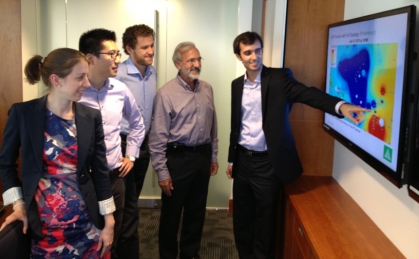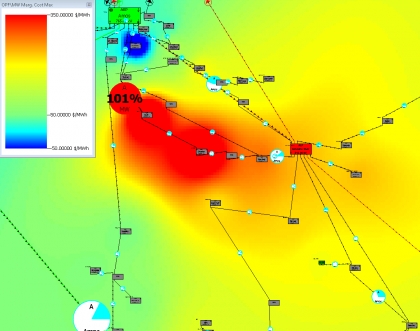Upgrading the Grid
New Algorithms Could Cut Costs, Add Renewables
By Mark Dwortzan

When power transmission lines reach their capacity in a particular region during high demand periods, controllers have little choice but to tap local power plants to keep the electricity flowing and prevent blackouts. This practice, which favors expensive, local generation sources such as coal and natural gas over cheaper, typically more remote, renewable sources such as wind farms and solar arrays, adds an estimated $5 billion to $10 billion per year to the cost of running the US power grid. As more and more renewable generation sources join the grid and increase transmission line congestion, that price is expected to rise substantially.
To mitigate this cost, College of Engineering researchers and collaborators at Tufts University and Northeastern University have a plan that could enable controllers to exploit cheaper, renewable generation sources when transmission lines become congested. Supported by a $1.2 million grant from the Department of Energy’s Advanced Research Programs Agency (ARPA-E) in 2012 and an additional $1 million as of September, the researchers are developing algorithms and software that can produce short-term changes in the power transmission network that redistribute power across the network and utilize renewable sources without overloading transmission lines.
They estimate that the algorithms they’re developing will save $3 billion to $7 billion annually and significantly improve the resilience of today’s power transmission network. Based on a fundamental law of physics dictating that electric current is distributed along the paths of least resistance, the algorithms are designed to discover, in real time, preferred reconfigurations of the transmission network.

“By removing a small number of critical transmission lines, you change the relative resistances across alternative network paths, and electric power redistributes itself, relieving the congestion,” said ProfessorMichael Caramanis (ME, SE), the project’s co-principal investigator along with Research Associate Professor Pablo Ruiz (ME), who is leading the research effort. “If you disconnect the right lines, you can relieve congestion, increase use of inexpensive power sources and lower congestion costs.”
Having already implemented their algorithms in reproducing real-life situations in collaboration with the PJM transmission system, the largest power market in the US covering many eastern states, the researchers—with the recent addition of Professor Yannis Paschalidis (ECE, SE)—are now fine-tuning their software. Their immediate goal is to provide new ways of integrating wind generation with lower costs while strengthening the power transmission network. But to achieve that goal entails wrestling with a lot of computational complexity. Out of tens of thousands of transmission lines, the software must select a few, perhaps four or five, whose connection or disconnection will minimize the “spilling” or waste of inexpensive wind generation that might occur during high-congestion periods.
“Based on our understanding of power markets, in which prices can vary every five minutes at each node of the network, we can infer which lines would be beneficial to disconnect and which not,” said Caramanis. “When we disconnect a line, we also know how it will change the power flow over every other line, and how much we will gain by relieving the transmission network capacity a little bit. The idea is to optimize the network to reduce costly congestion.”
 Over the next two-and-a-half years, the team plans to continue refining its algorithms in collaboration with PJM, two software companies and an energy consulting firm. It will also design tests and procedures to ensure that the dynamic reconfiguration of the transmission network causes no disruption in the security and stability of the power system. If the software is adopted across PJM or other vast transmission networks, controllers seeking to relieve congestion will have the capability to connect and disconnect selected transmission lines every half hour or hour as needed, rather than once or twice a month, as they do now—or even automate the process.
Over the next two-and-a-half years, the team plans to continue refining its algorithms in collaboration with PJM, two software companies and an energy consulting firm. It will also design tests and procedures to ensure that the dynamic reconfiguration of the transmission network causes no disruption in the security and stability of the power system. If the software is adopted across PJM or other vast transmission networks, controllers seeking to relieve congestion will have the capability to connect and disconnect selected transmission lines every half hour or hour as needed, rather than once or twice a month, as they do now—or even automate the process.